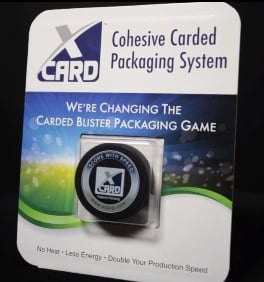In my last post I allude to this “trapped blister” packaging for retail, which, as the name implies, consists of a thermoformed blister sandwiched between a paperboard based “frame.” For years CPG companies have looked to trapped blister packs as a replacement for large clamshell packs at Big Box Retail, citing consumer frustration, sustainability, and cost savings as the driving motivations. Wrap rage and concerns about sustainability aside, these packs are often times cheaper than their clamshell counterparts, while maintaining similar shelf impact.
While the sustainability of these trapped blisters vs. clamshell packages remains to be third-party verified, many have claimed that simply the reduction in plastic renders the paper-based packs environmentally superior. Paper good, plastic bad, right? Recent research points to the exact opposite, however. In addition, many have noted that the plastic thermoform and paper-based portion of the trapped blister are not recyclable when separated at the MRF, due to the adhesive that exists on both substrates following the sealing process. Combined with the fact that PET thermoforms (clamshells) are now accepted for recycling in the majority of American communities, there are some compelling counter arguments to the “paper is good, plastic is bad” rhetoric.
So color me surprised when I stumbled upon Excel’s X Card, a trapped blister retail solution that does not require heat sealing; hence, leaves no adhesive contaminants, rendering both the plastic and paper component recyclable. Hurray for innovation!
While apparently this sealing technology—cohesive sealing, cold sealing, pressure sealing, etc.—has been around for a minute, I just learned the details while interviewing Todd Brandel, VP of Business Development, at Excel Displays and Packaging. He has been championing this retail packaging solution for the past two years, articulating its benefits from both an environmental, and cost savings standpoint. I was fortunate enough to have him answer a few of my questions about his X Card:
Me: Hey Todd, can you give me a little background on trapped blisters for retail and heat-sealing technology?
Todd: “Trapped blisters” is a subset of high visibility packaging; that is, any package where you can see the product through the window, be it via die cut window, transparent clamshell, or trapped blister pack. Blister cards and heat-sealing for retail have been around forever. Then club stores came along, with these huge trapped blister billboards. The reason they were so big is so you couldn’t stick the merchandise in your pocket and walk out of the store. Hence it eliminated the need for sales reps and security and saved retailers money. All these blisters and trapped blisters were done via heat sealing. The problem was, however, that heat sealing was a slow and frustrating process. Corrugate is a natural insulator so it takes a while to drive the heat through the board to activate the adhesive. So it was a love/hate relationship: CPGs and retailers loved it, but those creating the package—often times the co-packers—grew frustrated with the process.
And then came along some smart people that said, “there has to be a better way to do this!”
Me: And that’s where Excel comes in??? Tell me about how X Card solves this frustration.
Todd: Our X Card uses cohesive sealing, which means we use a cohesive glue to coat the board that only sticks to itself; think of Velcro—cohesive sealing is the same idea. While cohesive sealing, like heat-sealing, has been around for a bit, only Excel has innovated the process by which the boards are coated. In other words, most people in the industry using cohesive sealing use an offline process, meaning it is done as a separate operation from die-cutting. They use a flood coat of adhesive, and coat the entire card with glue. If you have seen this, it looks a lot like snot, a heavy coating of latex-based adhesive. What we do at Excel is coat the cards inline using a pre-determined pattern, depending on the requirements of the seal and package. Instead of coating the entire card with glue, we only coat the parts that will create the seal, saving material (glue), and also presenting a clean look behind the product.
Me: So you sell inline coated cards to those sealing the card to the thermoform, like the co-packers you mentioned; and, this makes their jobs easier, saving time and money they can then pass on to their retail partners?
Todd: That’s correct! And, our cards can be sealed on existing heat-sealing machines. It’s a win-win.
Me: And sustainability wise, these packs are superior to their heat-sealed counterparts because both the thermoformed blister and paper card can be easily separate and recycled. There is no adhesive contaminating the thermoform. And, you can use high concentration of post consumer recycled content in the thermoform and your board is already SFI certified?
Todd: You nailed it!
Me: Awesome, thanks for your help!
Learn about Dordan's thermoform package design.
Learn about Dordan's plastic blisters.

Above: X Card trapped blister solution for retail
